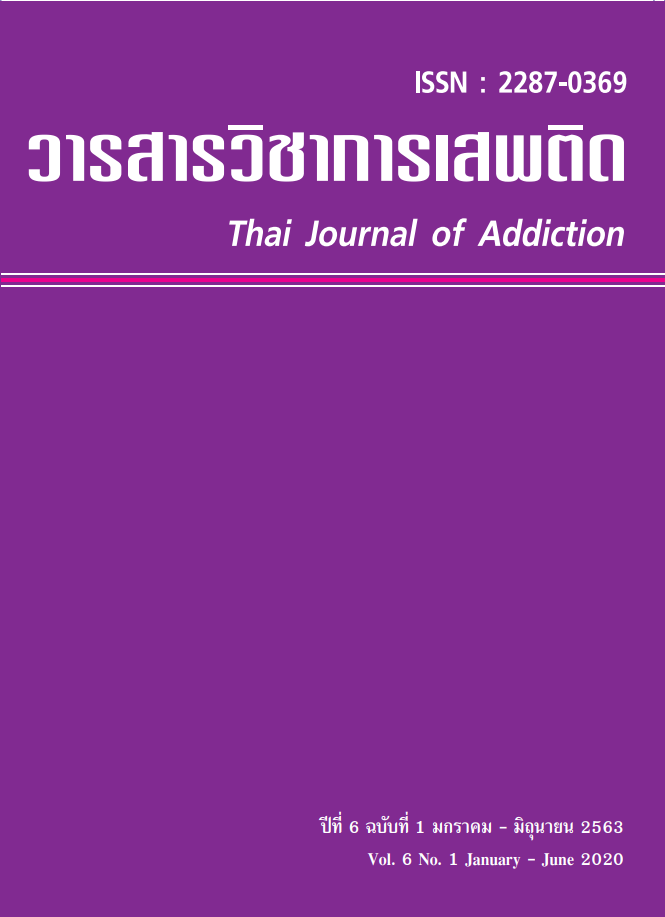The study of incident rate with relapse use of metamphetamine at Princess Mother National Institute on Drug Abuse Treatment (PMNIDAT)
Keywords:
Methamphetamine, Ice, Crystal meth, RelapseAbstract
Objective: 1. To study the incident rate with relapse use of metamphetamine at Princess Mother National Institute on Drug Abuse Treatment (PMNIDAT) 2. To study influent factor relapse use of metamphetamine at Princess Mother National Institute on Drug Abuse Treatment (PMNIDAT)
Methods: This is a cross sectional analytic study. Collect data from person who is using amphetamine repeated and admitted in rehabilitation ward from November 2018 to January 2019. Descriptive analysis chi-square test were used. Statistic significant factors were analyzed by multiple logistic regressions
Result: There were 54 % of repeated use of methamphetamine within 90 days. 63% of relapse uses of methamphetamine within 90 days were male. The ages between 18-29 years in relapse use within 90 days (p<0.001). Using amphetamines together with ice pills, 57.4% of relapse use within 90 days (p=0.013). Classification as addict was 88.9% ( p=0.005). The mean of first use methamphetamine ages less than 18 years in relapse use within 90 days (p=0.007). The relationship in the community that help each other,44.4%of relapse use group within 90 days (p=0.022). The feeling of community towards the patient is acceptable, understandable, 38.9%of relapse use group within 90 days (p=0.017). 79.6% of relapse use group within 90 days can buy drug in the community (p=0.023). When taking the statistically significant variable to analyze the multivariate, it is found that the most important factors are Patients aged 18-29 have 5.139 times more chance of relapse use (95% Cl of OR = 2.079-12.701).
References
ข้อมูลการบำบัดรักษาและฟื้นฟูผู้ติดยาเสพติดของประเทศ (บสต); 2560. [สืบค้น 20 กุมภาพันธ์ 2563].
เข้าถึงจาก: https://antidrugnew.moph.go.th
2. ศูนย์อำนวยการป้องกันและปราบปรามยาเสพติด กระทรวงสาธารณสุข. สภาพปัญหายาเสพติด
และสถิติเกี่ยวกับข้อมูลผู้เข้ารับการบำบัดรักษา; 2560.
3. สำนักงานบริหารการสาธารณสุขสำนักปลัดกระทรวงสาธารณสุข. สถิติผู้ป่วยสารเสพติดที่เข้ารับ
การรักษาทั่วประเทศประจำปี 2555-2557 ; 2559.
4. โรงพยาบาลธัญญารักษ์ กรมการแพทย์. สถิติผู้เข้ารับการบำบัดรักษา. รายงานประจำปี; 2561
[สืบค้น 20 กุมภาพันธ์ 2563]. เข้าถึงจาก:http://www.pmnidat.go.th/thai/index.php?option=com_
content&task=category§ionid=2&id=9&Itemid=53
5. กระทรวงสาธารณสุข. ยุทธศาสตร์ ตัวชี้วัด และแนวทางการจัดเก็บข้อมูล กระทรวงสาธารณสุข
ปีงบประมาณ พ.ศ.2559. [สืบค้น 25 มีนาคม 2563]. เข้าถึงจาก http://region5.moph.go.th/
docs/mophplan_2559_final.pdf
6. สำเนา นิลบรรพ์, บุญเรือง ศรีเหรัญ, อุษา คงทอง. ความสัมพันธ์เชิงสาเหตุของปัจจัยที่มีผลต่อ พฤติกรรม
การเสพยาซ้ำของผู้เสพเมทแอมเฟตามีน. วารสารบัณฑิตศึกษา มหาวิทยาลัยราชภัฏวไลยอลงกรณ์ ในพระ
บรมราชูปถัมภ์ 2559;10(1): 193-207.
7. ธชกานต์ ปัทมะศิริ. ปัจจัยทางสังคมที่มีผลต่อการติดยาเสพติดซ้ำของผู้รับการบำบัดยาเสพติดที่
โรงพยาบาลธัญญารักษ์ จังหวัดปทุมธานี. มหาวิทยาลัยเกษตรศาสตร์. กรุงเทพฯ: 2542.
8. ธนิตา หิรัญเทพ, อุมาพร อุดมทรัพยากุล, รณชยั คงสกนธ์. ปัจจัยที่สัมพันธ์กับการไม่เสพยาเสพติด
ซ้ำในผู้เข้ารับการบำบัดในระบบบังคับบำบัด. วารสารสมาคมจิตแพทย์แห่งประเทศไทย 2556; 58(2):
157-164
9. นันทา ชัยพิชิตพันธ์. การศึกษาปัจจัยที่มีผลต่อพฤติกรรมการเสพยาบ้าซ้ำของนักเรียนชั้น
มัธยมศึกษาที่เข้ารับการรักษาในโรงพยาบาลธัญญารักษ์. วิทยานิพนธ์ครุศาสตร มหาบัณฑิต สาขาวิชาสุข
ศึกษา จุฬาลงกรณ์มหาวิทยาลัย; 2541. [สืบค้น 25 มีนาคม 2563]. เข้าถึงจาก:
http://cuir.car.chula.ac.th/handle/123456789/12597



